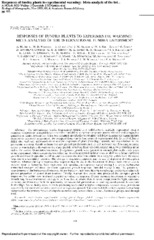Responses of tundra plants to experimental warming : meta-analysis of the international tundra experiment
Arft, A. M.; Walker, M. D.; Gurevitch, J.; Alatalo, J. M.; Bret-Harte, M. S.; Dale, M.; Diemer, M.; Gugerli, F.; Henry, G. H. R.; Jones, M. H.; Hollister, R. D.; Jónsdóttir, I. S.; Laine, K.; Lévesque, E.; Marion, G. M.; Molau, U.; Mølgaard, P.; Nordenhäll, U.; Raszhivin, V.; Robinson, C. H.; Starr, G.; Stenström, A.; Stenström, M.; Totland, Ørjan; Turner, P. L.; Walker, L. J.; Webber, P. J.; Welker, J. M.; Wookey, P. A.
Abstract
The International Tundra Experiment (ITEX) is a collaborative, multisite experiment using a common temperature manipulation to examine variability in species response across climatic and geographic gradients of tundra ecosystems. ITEX was designed specifically to examine variability in arctic and alpine species response to increased temperature. We compiled from one to four years of experimental data from 13 different ITEX sites and used meta-analysis to analyze responses of plant phenology, growth, and reproduction to experimental warming. Results indicate that key phenological events such as leaf bud burst and flowering occurred earlier in warmed plots throughout the study period; however, there was little impact on growth cessation at the end of the season. Quantitative measures of vegetative growth were greatest in warmed plots in the early years of the experiment, whereas reproductive effort and success increased in later years. A shift away from vegetative growth and toward reproductive effort and success in the fourth treatment year suggests a shift from the initial response to a secondary response. The change in vegetative response may be due to depletion of stored plant reserves, whereas the lag in reproductive response may be due to the formation of flower buds one to several seasons prior to flowering. Both vegetative and reproductive responses varied among life-forms; herbaceous forms had stronger and more consistent vegetative growth responses than did woody forms. The greater responsiveness of the herbaceous forms may be attributed to their more flexible morphology and to their relatively greater proportion of stored plant reserves. Finally, warmer, low arctic sites produced the strongest growth responses, but colder sites produced a greater reproductive response. Greater resource investment in vegetative growth may be a conservative strategy in the Low Arctic, where there is more competition for light, nutrients, or water, and there may be little opportunity for successful germination or seedling development. In contrast, in the High Arctic, heavy investment in producing seed under a higher temperature scenario may provide an opportunity for species to colonize patches of unvegetated ground. The observed differential response to warming suggests that the primary forces driving the response vary across climatic zones, functional groups, and through time.
Publisher
Ecological Society of AmericaRelated items
Showing items related by title, author, creator and subject.
-
Strong microsite control of seedling recruitment in tundra
Graae, Bente J.; Ejrnæs, Rasmus; Lang, Simone I.; Meineri, Eric; Ibarra, Pablo T.; Bruun, Hans Henrik (Peer reviewed; Journal article, 2010-12-19)The inclusion of environmental variation in studies of recruitment is a prerequisite for realistic predictions of the responses of vegetation to a changing environment. We investigated how seedling recruitment is affected ... -
Traditional plant functional groups explain variation in economic but not size‐related traits across the tundra biome
Thomas, Haydn J.D.; Myers-Smith, Isla H.; Bjorkman, Anne D.; Elmendorf, Sarah C.; Blok, Daan; Cornelissen, Johannes H. C.; Forbes, Bruce C.; Hollister, Robert D.; Normand, Signe; Prevéy, Janet S.; Rixen, C; Schaepman-Strub, G; Wilmking, M; Wipf, S; Cornwell, W; Kattge, J; Goetz, SJ; Guay, KC; Alatalo, JM; Anadon-Rosell, A; Angers-Blondin, S; Berner, LT; Björk, RG; Buchwal, A; Buras, A; Carbognani, M; Christie, K; Siegwart Collier, L; Cooper, Elisabeth J.; Eskelinen, A; Frei, ER; Grau, O; Grogan, P; Hallinger, M; Heijman, MMPD; Hermanutz, L; Hudson, JMG; Hulber, K; Iturrate-Garcia, M; Iversen, CM; Jaroszynska, Francesca Orinda Holl; Johnstone, JF; Kaarlejärvi, E; Kulonen, A; Lamarque, LJ; Lévesque, E; Little, CJ; Michelsen, A; Milbau, A; Nabe-Nielsen, J; Nielsen, SS; Ninot, JM; Oberbauer, SF; Olofsson, J; Onipchenko, VG; Petraglia, A; Rumpf, SB; Semenchuk, Philipp; Soudzilovskaia, NA; Spasojevic, MJ; Speed, James David Mervyn; Tape, KD; Te Beest, M; Tomaselli, M; Trant, A; Treier, UA; Venn, S; Vowles, T; Weijers, S; Zamin, T; Atkin, OK; Bahn, M; Blonder, B; Campetella, G; Cerabolini, BEL; Chapin III, FS; Dainese, M; de Vries, FT; Díaz, S; Green, W; Jackson, R; Manning, P; Niinemets, Ü; Ozinga, WA; Penuelas, J; Reich, PB; Schamp, B; Sheremetev, S; van Bodegom, Peter Michiel (Peer reviewed; Journal article, 2019-01)Aim : Plant functional groups are widely used in community ecology and earth system modelling to describe trait variation within and across plant communities. However, this approach rests on the assumption that functional ... -
Reindeer trampling promotes vegetation changes in tundra heathlands: Results from a simulation experiment
Egelkraut, Dagmar Dorothea; Barthelemy, Hélène; Olofsson, Johan (Journal article; Peer reviewed, 2020)Question Herbivores exert strong influences on vegetation through activities such as trampling, defoliation, and fertilization. The combined effect of these activities on plant performance may cause dramatic vegetation ...
